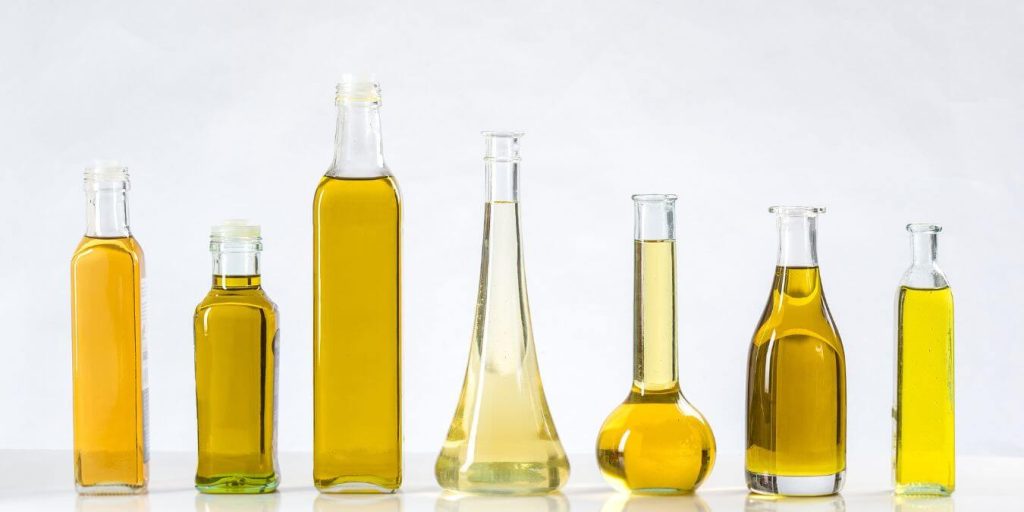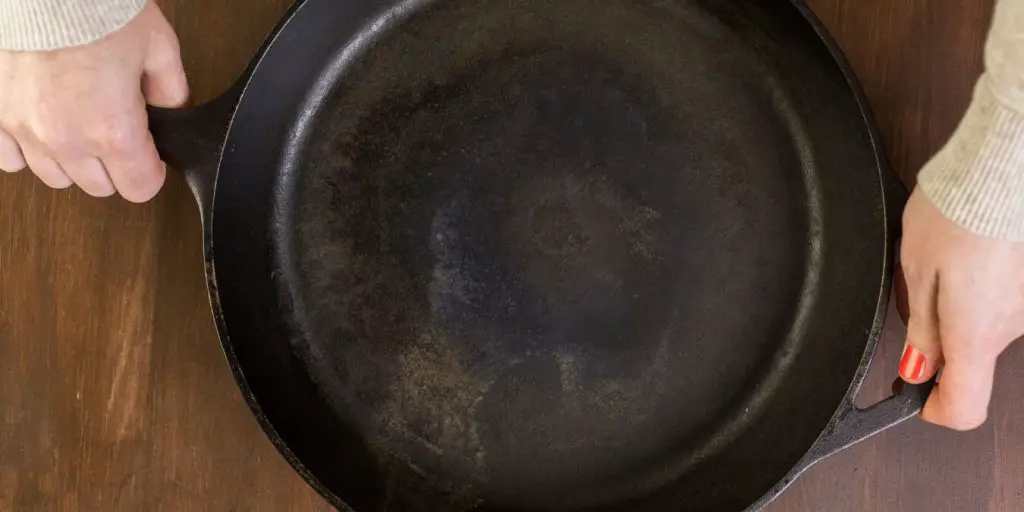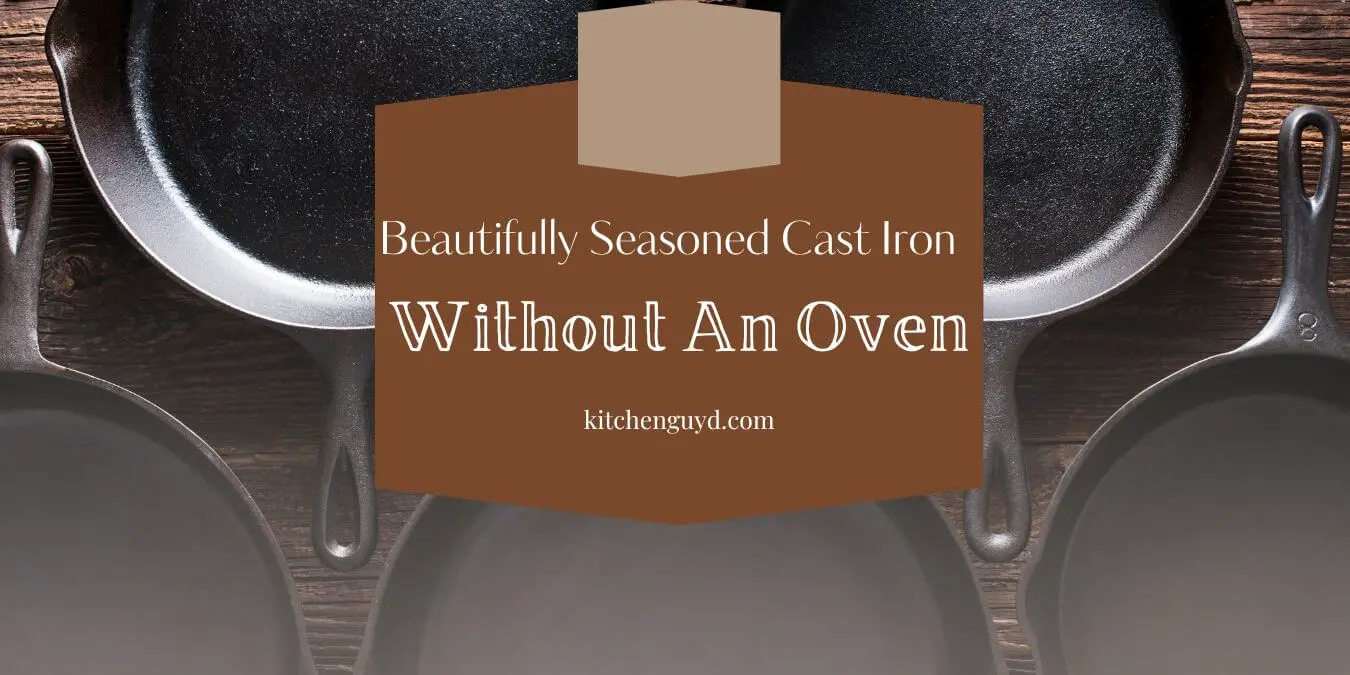A cast iron skillet is one of the most versatile tools you can have in your kitchen; however, if you want to get the most out of your skillet as possible, you need to season it. Seasoning your cast iron skillet forms a natural, protective cooking surface that can prevent your pan from rusting.
Even though a lot of people are familiar with seasoning a cast iron skillet in the oven, you might be wondering how to season cast iron without oven. That way, you can save time and energy.
If you want to season your cast iron without an oven, what do you need to do?
Table of Contents
- Before Seasoning Cast Iron Pan: A Few Things To Know
- A Step-By-Step Guide: How To Season Cast Iron Without Oven
- FAQs
Before Seasoning Cast Iron Pan: A Few Things To Know

Before you start seasoning your cast iron skillet, there are several important points to keep in mind. They include:
Why Season Cast Iron?
There are several reasons why you should take the time to season your cast iron skillet. They include:
- When you season your cast iron skillet well, it retains heat better, which can make it easier for you to cook your food evenly.
- Seasoning your cast iron skillet makes it easier to clean. Food bits do not stick to your pan as well, which means you don’t have to spend as much time cleaning it.
- Seasoning a cast iron skillet will truly turn it into a non-stick pan. As a result, you will not need to use as much oil while cooking, which can help you save money.
- Seasoning your cast iron skillet means that you will have a chemical-free alternative to traditional pans.
For all of these reasons, you must season your cast iron skillet.
Fires From Using High Heat and Oil
When you are seasoning your cast iron skillet, you need to be aware that fires could start from using oil and high heat.
The smoke point can vary significantly depending on the oil or grease you are using to season your cast iron skillet. For example, the vast majority of vegetable oils will start to catch fire at 450 degrees F. On the other hand, animal fats usually start to catch fire at around 375 degrees F.
If you have a fire, it can spread quickly, so use extreme caution when you season your cast iron skillet.
Smoke and Fumes Can Be a Problem
During this process, you should be aware that smoke and fumes can be a significant problem. Even if your oil does not catch fire, it can still start to smoke.
Therefore, ensure you have good ventilation. This is particularly true if you suffer from chronic respiratory conditions, such as allergies and asthma. You do not want the air quality in your home to suffer during the seasoning process, so ensure you have good ventilation before you start.
You might want to open the windows, and you should turn any range hood vents you have in the kitchen all the way up.
Best Oil To Season Cast Iron Pan

If you are interested in the best oils to season your cast iron skillet, there are a few options to consider. They include:
- Grapeseed Oil: Grapeseed oil is one of the most popular oils for seasoning a cast iron skillet among professional chefs. It has a very high smoke point, about 420 degrees F, which allows you to use high temperatures during the process. It will heat up the pan very quickly and create a firm bond between the oil and the pan. It also has a neutral aroma, so it should not change the flavor of the dishes you make. This oil is also healthier than many of the alternatives.
- Avocado Oil: Avocado oil is also a very popular oil because it has a high smoke point of 520 degrees F. Keep in mind that the pan will be very dangerous at this temperature. Because it bonds so strongly, the chances of your breaking the bond while cooking later are slim to none, but you might not be able to get your cast iron to the temperature without a professional kitchen.
- Canola Oil: If you are looking for the least expensive option, consider going with canola oil. It is inexpensive, available everywhere, and has a high smoke point. Canola oil is generally better than other vegetable oils because of its neutral flavor, but it doesn’t have as high of a smoke point as grapeseed or avocado oil. Canola oil has a smoke point of 400 degrees F. This could make it safer.
- Olive Oil: Some people like seasoning a cast iron skillet with olive oil because it has a beautiful aroma and rich flavor. It is also healthier than many of the other options. On the other hand, it has a much lower smoke point of 375 degrees F, so it will take longer to complete the seasoning process.
- Flaxseed Oil: Next, you might want to consider flaxseed oil. Even though it has a lower smoke point, it bonds to the cast iron nicely and dries naturally. You will need to go through multiple rounds of seasoning because of the lower temperature, but it does not have any flavors that will alter the taste of your dishes.
Think carefully about the benefits and drawbacks of each of these options before you decide what is right for your needs.
How To Season Old Cast Iron vs. New Cast Iron Pan
When seasoning your cast iron skillet, think about how old it is.

Seasoning New Cast Iron Pans
Newer cast iron pans tend to be thicker and heavier. This means that it might take you longer to get that good, solid, protective coat on a newer cast iron skillet when compared to an old one.
Also, keep in mind that many cast iron cookware brands pre-season their pans. Does this mean that you don’t have to do anything? Not entirely. It is still a good idea with a new cast iron pan to wash and give it an at-home seasoning. This ensures it is well prepared for your cooking needs.
Seasoning Old Cast Iron
If you are re-seasoning a cast iron skillet that you have already seasoned in the past, it should not take as long to complete the process. If the pan is in good shape, it should just take a thin layer of oil and heat to get the pan back in ship shape.
However, sometimes you might have a pan that needs a little more love. For example you may need to scour the pan to get off layers of fat that have built up over time. You might also need to address rust that has formed from improper cleaning or storage.
So, by now, you have decided what oil to use and have a beautifully seasoned cast iron pan. Right!? Let’s get into the steps needed for this “without an oven method”.
A Step-By-Step Guide: How To Season Cast Iron Without Oven
The steps you need to follow to season your cast iron without an oven include:
1. Wash and Dry the Cast Iron
First, you need to wash and dry your cast iron pan thoroughly. Particularly if your cast iron is brand-new, you need to remove any chemicals or contaminants that might be present.
Once you are done washing your cast iron, make sure it is completely dry. If it is not dry, you can put the cast iron on your stove at low heat to evaporate any moisture that might be left over.
You must get rid of the added moisture if you want the bond to form properly.
2. Apply the Oil Thoroughly
Next, you need to rub every inch of your cast iron skillet with oil.
Regardless of the type of oil you use, you must make sure you coat the pan completely. This includes the edges of the pan.
You should also make sure you rub the oil into the pan. When you are done, the pan should not look greasy. If you feel like the pan still looks a bit crazy, or if you feel like the coat is not even, you can use your fingers to rub the oil into the pan once again.
3. Place the Cast Iron on a Hot Burner
Now, it is time to move the pan to the burner. Turn the burner up and bring the pan to medium-high or high heat. The final temperature should depend on the type of oil you use.
Remember that different oils have different smoke points, so you need to keep a close eye on your pan during the process. As the oil gets hot on the pan, it will polymerize to the pan like a protective veneer.
Keep in mind that the oil may start to smoke, so make sure there is good ventilation in the room.
4. Remove From the Burner and Discard the Excess Oil
After 30 minutes, remove the pan from the burner. Discard the extra oil. Remember that the oil is hot, so use extreme caution.
Once the cast iron cools down to an appropriate temperature, repeat the process. Rub the oil into the pan once again, put the pan on the burner, let it get hot, and repeat the cycle. The lower the smoke point of the oil, the more times you will have to repeat the process to finish it.
Once you are done with the seasoning process, it is important to use the cast iron skillet regularly. If you don’t use it too often, it could start to get gunky. The oil could even turn rancid. If you use the skillet regularly, it should perform better.
FAQs
Some of the most common questions people ask about seasoning a cast iron skillet include:
For your cast iron skillet to behave well, you should add oil after every use; however, you should season your cast iron skillet approximately two to three times per year.
No, you do not need to season enameled cast iron. The enamel is resistant to crusting, burning, and sticking, so you do not need to season it as you do traditional cast iron. This makes the skillet much easier to take care of.
If you have rust on the bottom of your cast iron skillet, you can remove it. Use a fine piece of steel wool or a water/vinegar wash to remove the rust from the pan. You should be able to remove the rust and turn your skillet into raw cast iron once again. Once you are done washing your cast iron skillet, dry it with a cloth. If you allow your wet cast iron skillet to air-dry it will eventually rust.
The biggest reason why a cast iron cookware might be sticky is due to a buildup of excessive oil. This can happen if too much oil is used to season the pan, if the wrong type of oil is used, or if the skillet is not hot enough for the oil to polymerize directly to the surface.
When you season your cast iron skillet, make sure to turn the temperature up to prevent the pan from getting too sticky.
When you clean your cast iron skillet, you can use a mild dish soap. Then, use a scouring pad or a cleaning brush that is cast iron friendly. Wash the pan, scrub the food bits off, rinse it, and then wipe it with a cloth to make sure it is dry. Finally, add a few more drops of oil and smooth out the layer with a paper towel to protect the cast iron skillet. If you have food pieces that are burnt into the skillet, you can use steel wool to remove them.
